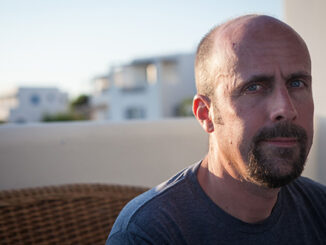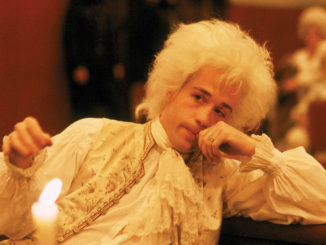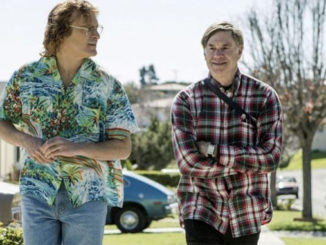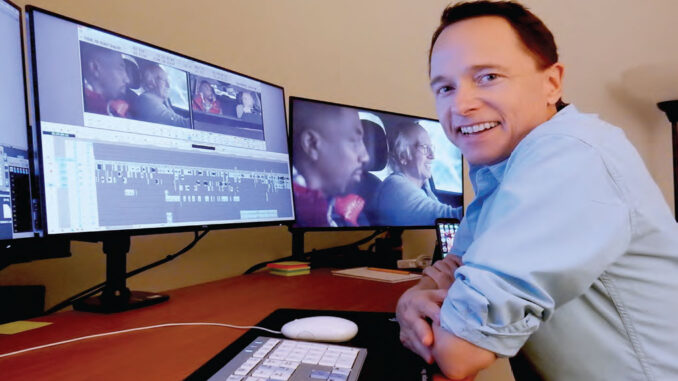
By Roger Nygard
Sacha Baron Cohen calls editing “the most precise craft that affects the success or failure of your jokes.” Larry David has said, “When I think about doing another season of ‘Curb Your Enthusiasm,’ it’s not the writing that’s daunting, it’s the editing.”
Why is editing such a hard part of the comedy process? One reason is because there is little room for error. When something that is supposed to be funny isn’t, it’s obvious. Two frames can make the difference between funny and not funny. If your skills aren’t razor sharp, it truly stands out.
In 2007 I interviewed for a job editing Season Six of “Curb Your Enthusiasm.” When I met Larry David, he asked, “Why do you want to work on this show?”
I said, “I want to learn from you, Larry. I want to see how you do what you do from the inside.”
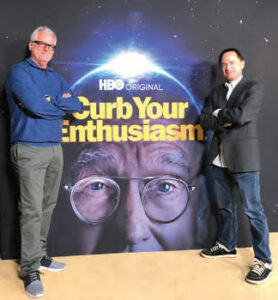
He chuckled, pretended he wasn’t flattered, and said, “You can’t learn anything from me.” I also said that working with him would be like an opportunity to work with one of the greats like Ernie Kovacs or Phil Silvers—except those guys are dead. He loved the comparison to Phil Silvers, who it turned out was a comedy hero of his. I got the job.
In 2018, I was hired on “Grey’s Anatomy” because the new showrunner, Krista Vernoff, wanted to steer the show back toward its comedic roots. One day, one of the other editors took me aside and asked, “How do you edit comedy?” I thought about how comedy and drama are such different beasts. I jotted down a quick list of comedy-editing precepts for him. And then I kept going. Cut to: three years later and I had completed a comedy-editing book. I figured that since I had various funny people trapped in an edit bay all day, they should be able to tell me how they find the funny.
Judd Apatow protested that comedy rules are hard to define. But he gamely tried. “It’s always about creating surprise or suddenly moving in a direction an audience doesn’t expect.” Sacha Baron Cohen said his goal is also to be unexpected, to show the audience something they’ve never seen before. “Even if the comic principles being used may be familiar, the scene itself should be original. I think Ali G made an impact because no one had seen that style of comedy before, in England at least, where somebody is asking ridiculous questions to a real person, who is an expert and answering seriously. So, it felt new and surprising. With ‘Borat,’ there hadn’t been a film where real people were moving the plot along.”
When Mike Binder is writing, he said his goal is to have an audience reaction be: “Wow. I didn’t expect that character to say that—and it’s true.” A double win. Surprise and truth. When I was editing Mike Binder’s documentary-series “The Comedy Store,” in one of the outtakes, comedian Whitney Cummings revealed her secret to understanding comedy: “Tell the truth.” She asks herself, “What’s the elephant in the living room? [When you were growing up,] what was the thing you weren’t allowed to say? The taboo things, the things that were off-limits, the things that we all experience but keep in the shadows. That’s where all the meat is.”
‘IT’S ALWAYS ABOUT CREATING SURPRISE OR SUDDENLY MOVING IN A DIRECTION AN AUDIENCE DOESN’T EXPECT.’
Steve Allen (the first host of “The Tonight Show” in 1954) once said, “Tragedy plus time equals comedy.” When somebody falls down, we laugh. The more it hurts, the funnier it gets. In “Veep,” when Jonah hit his head on the ceiling, the louder and more solid I made the sound effect (in an homage to The Three Stooges), the funnier it got. I also removed a single frame to speed up each hit to make the bumps appear even more violent. Watching awkward or clumsy behavior, we laugh and think, “I’m glad that’s not me.”
Julian Doyle, editor of the Monty Python movies, once lamented to me, “My wife laughs any time I get hurt. I don’t know what she’s got against me, but if I fall over, she finds that hysterical, me hurting myself.”
I said, “I hope she won’t be at your funeral cackling wildly.”
Julian replied, “She’ll think it’s very funny.”
All these funny folks identified many sources of comedy, but surprise, truth, and pain are the top three. So how do you translate this information into successful editorial techniques? I boiled down what they told me into dozens of comedy-editing guidelines. I’ll list some of the key pointers, and if you follow these rules, your end product will be 15% funnier than the next editor’s. (This figure is supported by no actual scientific data.)
![]() PICK THE RIGHT TAKES.
PICK THE RIGHT TAKES.
Can you teach somebody to have good taste? Absolutely. In his book “Outliers: The Story of Success” (2008), Malcolm Gladwell describes the 10,000-hour rule, asserting the way to expertise is by practicing your specialty. Study comedies and practice more than your peers so you will stand out. If you have the stamina to stick with it, eventually you will be calling the shots. But while practicing, it will help greatly to understand the following nine precepts.
![]() FASTER COMEDY IS FUNNIER COMEDY.
FASTER COMEDY IS FUNNIER COMEDY.
Speed everything up. The right pace is often faster from what felt right to the writer, the director, or the actors on the set. Get to the punch lines cleaner and quicker. Good writing is concise writing. The same holds for dialog. But don’t cut fast just for the sake of speed. The idea is to speed things up until the pace feels appropriate. Jokes, scenes, acts, and stories have to continually increase in pace, magnitude, and energy. Running gags have to get bigger and go further each time. The climax must have more intensity than anything that preceded it. “Anticlimactic” is the label applied to a scene or an ending that violates this rule.
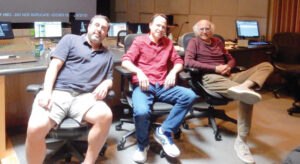
Monty Python editor Julian Doyle has an axiom: “If an audience does not want to know what’s going to happen next, then cut fast. When they do want to know what’s going to happen next, slow down.” You have to know where the audience’s anticipation level is at any particular time. If they are ahead of the story, you’re in trouble. Move as fast as possible until the bomb is on the bus and it’s about to explode. Then you can slow time down. Because the audience wants to know what’s going to happen. Who’s going to die? How are they going to get out of it?
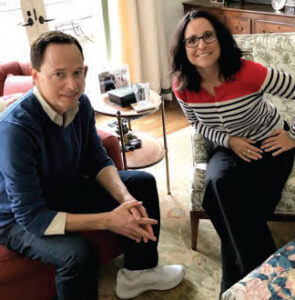 When I asked comedy-couple Brad Hall and Julia Louis-Dreyfus about their philosophy of editing, Brad said, “Faster, faster, faster —” Julia overlapped him. “Faster. Yes! Forget comedy. Faster, faster, faster applies to everything. Because then slowing down has enormous significance. It becomes more impactful.”
When I asked comedy-couple Brad Hall and Julia Louis-Dreyfus about their philosophy of editing, Brad said, “Faster, faster, faster —” Julia overlapped him. “Faster. Yes! Forget comedy. Faster, faster, faster applies to everything. Because then slowing down has enormous significance. It becomes more impactful.”
“There’s a thing in acting school where you learn about ‘arresting,’” Brad said. “Let’s say you’re having a conversation, you’ve picked the business of drinking coffee, then suddenly you stop. The stopping has so much impact. The arrested activity is the whole thing. If you create motion in a scene editorially, and then hold for that beat when she’s listening, all of a sudden, you’ve created a moment.”
![]() KILL THE PAUSES.
KILL THE PAUSES.
The enemy of comedy is the unnecessary pause. There is no pausing in comedy unless you choose to pause. “Curb Your Enthusiasm” co-showrunner Jeff Schaffer said, “The only reason to pause is when the joke demands the pause. Otherwise keep going. Go to the next joke. Go to the next moment.”
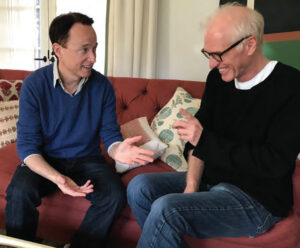
A sign of an amateur is when they leave a momentum killer, like a pause, or “um,” or “you know,” underneath a reaction shot. If we are seeing somebody other than the speaker, the editor has total control over the dialogue and should remove anything unnecessary. If the camera is stable enough, I have brazenly jump cut out an “um” while looking right at an actor who paused mid-sentence. If the jump cut is seamless, I keep it. And there is a fluid morph option that can help smooth that pauseectomy.
When I was cutting “Crashing,” I had to slow down my pacing. I had just come off of “Veep,” so my natural instinct was to put the pedal to the metal. But then I realized I needed to put some pauses back in. We needed to emphasize awkward moments, so we could feel what Pete Holmes was feeling as he was starting out as a mediocre comedian surrounded by better comedians. How long should a pause be? No longer than absolutely necessary to make a point. Any editor can lay down a dramatic pause. The good editor knows when to cut it off. If there is too much pausing, the pause loses meaning.
![]() FEATURE THE PUNCH LINE.
FEATURE THE PUNCH LINE.
When I was editing the series “The Mind of the Married Man,” I made the mistake of cutting away five frames before the end of a punch line. I was trying to match continuity. But continuity is secondary to comedy. Never cut away from speakers before they completely finish saying a punch line. Jokes are not as funny delivered off-camera. Whenever I encounter a funny line, I look for the best angle to feature it on the face.
![]() SAVE THE BEST FOR LAST.
SAVE THE BEST FOR LAST.
Put the funniest part of a line at the end of the sentence. Often you will find the biggest laugh is buried somewhere before the end. In journalism that’s called burying the lede. When possible, move the biggest moment to the end of the sentence, or to the end of the scene, or the end of the act. Don’t go on after the best part. After the punch line, it’s time for a new bit, or a new set up.
![]() SHOW THE BODY LANGUAGE.
SHOW THE BODY LANGUAGE.
Comedy performances are often funnier in wide shots because you see more body language. You can’t see how awkwardly somebody is standing if they are only framed from the shoulders up. Close-ups are for dramatic moments, to feel emotion. If you want a scene to get funnier, try to widen it out.
![]() GIVE MORE ATTENTION TO THE SET UPS.
GIVE MORE ATTENTION TO THE SET UPS.
A setup must be concise, well-annunciated, appropriately-paced, and clear, or the punch line is not going to land. It’s the same as a thriller, where the anticipation and tension of a scene grows. “Barry” co-creator Alec Berg finds that building a laugh is similar to building a scare in a horror movie. There is tension and release. He said filmmakers sometimes make the mistake of trying to keep too many laughs. “There’s a sense that more laughs means more comedy. But an A+ laugh is exponential. It’s not twice as good as a B+ laugh. An A+ laugh is ten times as good. If you create a film that has four or five massive laughs, it’s a classic. If you make something that has one hundred B+ laughs, it’s not as memorable. Those big laughs are the ones that you have to curate. And sometimes that means not being funny for a stretch of time to build that tension. Those are genre-defining laughs.”
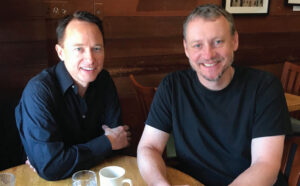
If Sacha Baron Cohen believes a joke is funny, yet the punch line is not working, before he gives up on it, he will analyze the setup. “The setup is like math. If you don’t have the building blocks, you can never be good at math. It’s the same with comedy. The blocks have to be crystal clear. What does this person think? What does the other person think? Particularly if you have a scene which is farcical. You have to make the progression absolutely clear.”
‘NOTICE HOW MANY LINES ARE DELIVERED OVER THE BACK OF LARRY DAVID’S HEAD.’
Jeff Schaffer is always focused on getting solid setups because you don’t want people to be thinking (and trying to figure out the plot) when they should be laughing. “The audience has to clearly know what the game is: ‘Larry is lying to the hotel clerk because he wants the coffee beans.’ Once everybody understands the situation, then you can run the scene and do the jokes.” On “Curb Your Enthusiasm,” we spent more time working on fixing setups than improving punch lines. Next time you watch an episode, notice how many lines are delivered over the back of Larry David’s head, or under reaction shots, to improve setups.
![]() CLEAR THE PATH BETWEEN SETUP AND PUNCH LINE.
CLEAR THE PATH BETWEEN SETUP AND PUNCH LINE.
Eliminate everything extraneous between the setup and the punch line, to get there as quickly and cleanly as possible. Remove unnecessary pauses, bad grammar, imprecise annunciation, inelegant visuals, anything that takes you out of the moment or reminds you that you’re watching a screen. “Curb Your Enthusiasm” editor Steven Rasch said he thinks of editing like proofreading a college paper. “Take out all the typos and bad grammar and it improves, even if it isn’t stellar. If you take out all the things in a scene that are not great, it gets better. You might have a terrific ensemble with one bad actor you have to minimize.” How do you know when it’s bad acting? Steven said: “Cut whatever reveals that it is actors talking, not characters talking.” Actors look at marks, they look in the lens, they smack their lips, they fumble their lines. Remove the impediments.
![]() KEEP IT REAL.
KEEP IT REAL.
A humorous moment is funnier when it seems like it could really happen. Good dramas season storylines with humor. Somebody trying to be funny is not as funny as somebody trying to be serious while caught up in a crazy situation. Whether broad or serious, once you set the tone, don’t violate the level of reality or the audience will object. I often sacrifice moments of comedy, removing jokes to keep things as dramatic as possible. Then the remaining jokes play funnier. The more believable and grounded a story is, the stronger the jokes land.
 CREATE THREE-PART STRUCTURE OUT OF THE CHAOS.
CREATE THREE-PART STRUCTURE OUT OF THE CHAOS.
Life is absurd. That is a message the Universe is sending out every day. But humans are pattern seekers. We look to the sky and impose a framing of organized constellations on a random scattering of stars. Disarray causes anxiety. Patterns are pleasing. We prefer to edit our world, to line things up, to attempt to control the chaos.
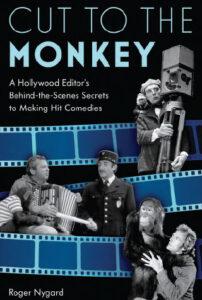 The strongest geometric figure is a triangle. Similarly, the strongest multi-part joke has three sections, or three examples, or three beats. It’s the rule of three. Three people walk into a bar, not two or four. Goldilocks meets three bears. There are three wishes. Storytelling works best with three-act structure. In cutting a montage, showing three shots feels right. Two feels inadequate and four begins to verge on overindulgence. Editing is finding the most concise and effective organization of myriad chaotic pieces.
The strongest geometric figure is a triangle. Similarly, the strongest multi-part joke has three sections, or three examples, or three beats. It’s the rule of three. Three people walk into a bar, not two or four. Goldilocks meets three bears. There are three wishes. Storytelling works best with three-act structure. In cutting a montage, showing three shots feels right. Two feels inadequate and four begins to verge on overindulgence. Editing is finding the most concise and effective organization of myriad chaotic pieces.
An editor is expected to bring a fresh perspective to a story, to a scene, to a line of dialogue, and to the filmic artform overall. Art helps others see a slice of the world from a new perspective, the way the artist saw it. When an editor finds a cleaner and less obvious path, it pleases and surprises the audience.
They like surprises. And truth. And pain. They want it all, but they want it faster.
This essay was drawn from Roger Nygard’s new book “Cut to the Monkey,” published by Applause Books. Nygard has edited Emmy-nominated episodes of “Veep,” “Curb Your Enthusiasm,” and “Who Is America?”


